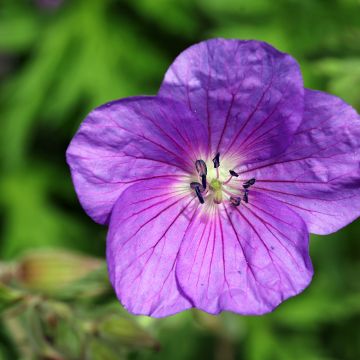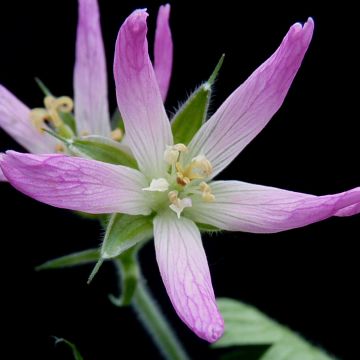

Geranium clarkei Kashmir Blue
Geranium clarkei Kashmir Blue
Geranium clarkei Kashmir Blue
Cranesbill, Hardy Geranium
This item cannot be shipped to the selected country
Delivery charge from €5.90
More information
Schedule delivery date,
and select date in basket
This plant carries a 12 months recovery warranty
More information
We guarantee the quality of our plants for a full growing cycle, and will replace at our expense any plant that fails to recover under normal climatic and planting conditions.
From €5.90 for pickup delivery and €6.90 for home delivery
Express home delivery from €8.90.
Does this plant fit my garden?
Set up your Plantfit profile →
Description
The Kashmir Blue Geranium clarkei is a creeping perennial, forming spreading stems with deeply lobed leaves. Cup-shaped flowers in the summer, of lilac-blue veined with red. Finely cut foliage, semi-evergreen. A fast-growing plant, forming beautiful ground cover in all exposures, in cool but well-drained soil.
Geranium clarkei 'Kashmir Blue' belongs to the Geraniaceae family. This rhizomatous perennial has a creeping habit. The type species G.clarkei Yeo is native to the western Himalayas, in India, where it grows in mountain meadows of Kashmir. The rounded and regular clump will reach a height of 45 cm (18in), with a spread of 60 cm (24in). It has rapid growth. The flowering, nectar- and honey-producing, lasts all summer from June to September, with a break during the hottest days of July-August. The inflorescence is a compound cyme of round and open flowers, blue-lilac veined with purple. The flowers have a translucent texture reminiscent of crepe paper, measuring 4 cm (2in) in diameter. The fruits are long and thin, and open to project the seeds further away. This geranium has deciduous to semi-evergreen foliage, composed of leaves divided into seven lobes, medium green, 5 to 15 cm (2 to 6in) long, each lobe deeply cut into narrow and pointed segments. It forms a non-invasive ground cover.
Geranium clarkei 'Kashmir Blue' is ideal for borders, in front of beds of plants or bushes with not too shallow roots. Perennial geraniums offer a good solution to prevent the proliferation of weeds. This is particularly interesting for the base of roses. The year following planting, with a rate of one plant every 60 cm (24in), the entire space between and under the rose bushes will be covered with flowers and foliage, without hindering the growth and flowering of the roses.
Report an error about the product description
Geranium clarkei Kashmir Blue in pictures




Flowering
Foliage
Plant habit
Botanical data
Geranium
clarkei
Kashmir Blue
Geraniaceae
Cranesbill, Hardy Geranium
Cultivar or hybrid
Other Hardy Geranium - Cranesbill
Planting and care
Plant Geranium clarkei 'Kashmir Blue' in autumn or spring in fertile, well-drained, well-worked, humus-bearing soil that retains moisture (although it does tolerate short periods of drought). It dislikes stagnant moisture but can tolerate some limestone. In poor soil, add organic fertiliser or well-decomposed compost at the start of the gorwing season. This geranium adapts to all exposures except scorching sun and dense shade. In a flowerbed, leave at least 50 cm (20in) spacing between plants. In the middle of summer, lightly prune faded stems and leaves to encourage regrowth. In spring, when the first buds appear, prune to rejuvenate the plant and divide large clumps.
Planting period
Intended location
Care
-
, onOrder confirmed
Reply from on Promesse de fleurs
Haven't found what you were looking for?
Hardiness is the lowest winter temperature a plant can endure without suffering serious damage or even dying. However, hardiness is affected by location (a sheltered area, such as a patio), protection (winter cover) and soil type (hardiness is improved by well-drained soil).

Photo Sharing Terms & Conditions
In order to encourage gardeners to interact and share their experiences, Promesse de fleurs offers various media enabling content to be uploaded onto its Site - in particular via the ‘Photo sharing’ module.
The User agrees to refrain from:
- Posting any content that is illegal, prejudicial, insulting, racist, inciteful to hatred, revisionist, contrary to public decency, that infringes on privacy or on the privacy rights of third parties, in particular the publicity rights of persons and goods, intellectual property rights, or the right to privacy.
- Submitting content on behalf of a third party;
- Impersonate the identity of a third party and/or publish any personal information about a third party;
In general, the User undertakes to refrain from any unethical behaviour.
All Content (in particular text, comments, files, images, photos, videos, creative works, etc.), which may be subject to property or intellectual property rights, image or other private rights, shall remain the property of the User, subject to the limited rights granted by the terms of the licence granted by Promesse de fleurs as stated below. Users are at liberty to publish or not to publish such Content on the Site, notably via the ‘Photo Sharing’ facility, and accept that this Content shall be made public and freely accessible, notably on the Internet.
Users further acknowledge, undertake to have ,and guarantee that they hold all necessary rights and permissions to publish such material on the Site, in particular with regard to the legislation in force pertaining to any privacy, property, intellectual property, image, or contractual rights, or rights of any other nature. By publishing such Content on the Site, Users acknowledge accepting full liability as publishers of the Content within the meaning of the law, and grant Promesse de fleurs, free of charge, an inclusive, worldwide licence for the said Content for the entire duration of its publication, including all reproduction, representation, up/downloading, displaying, performing, transmission, and storage rights.
Users also grant permission for their name to be linked to the Content and accept that this link may not always be made available.
By engaging in posting material, Users consent to their Content becoming automatically accessible on the Internet, in particular on other sites and/or blogs and/or web pages of the Promesse de fleurs site, including in particular social pages and the Promesse de fleurs catalogue.
Users may secure the removal of entrusted content free of charge by issuing a simple request via our contact form.
The flowering period indicated on our website applies to countries and regions located in USDA zone 8 (France, the United Kingdom, Ireland, the Netherlands, etc.)
It will vary according to where you live:
- In zones 9 to 10 (Italy, Spain, Greece, etc.), flowering will occur about 2 to 4 weeks earlier.
- In zones 6 to 7 (Germany, Poland, Slovenia, and lower mountainous regions), flowering will be delayed by 2 to 3 weeks.
- In zone 5 (Central Europe, Scandinavia), blooming will be delayed by 3 to 5 weeks.
In temperate climates, pruning of spring-flowering shrubs (forsythia, spireas, etc.) should be done just after flowering.
Pruning of summer-flowering shrubs (Indian Lilac, Perovskia, etc.) can be done in winter or spring.
In cold regions as well as with frost-sensitive plants, avoid pruning too early when severe frosts may still occur.
The planting period indicated on our website applies to countries and regions located in USDA zone 8 (France, United Kingdom, Ireland, Netherlands).
It will vary according to where you live:
- In Mediterranean zones (Marseille, Madrid, Milan, etc.), autumn and winter are the best planting periods.
- In continental zones (Strasbourg, Munich, Vienna, etc.), delay planting by 2 to 3 weeks in spring and bring it forward by 2 to 4 weeks in autumn.
- In mountainous regions (the Alps, Pyrenees, Carpathians, etc.), it is best to plant in late spring (May-June) or late summer (August-September).
The harvesting period indicated on our website applies to countries and regions in USDA zone 8 (France, England, Ireland, the Netherlands).
In colder areas (Scandinavia, Poland, Austria...) fruit and vegetable harvests are likely to be delayed by 3-4 weeks.
In warmer areas (Italy, Spain, Greece, etc.), harvesting will probably take place earlier, depending on weather conditions.
The sowing periods indicated on our website apply to countries and regions within USDA Zone 8 (France, UK, Ireland, Netherlands).
In colder areas (Scandinavia, Poland, Austria...), delay any outdoor sowing by 3-4 weeks, or sow under glass.
In warmer climes (Italy, Spain, Greece, etc.), bring outdoor sowing forward by a few weeks.














































